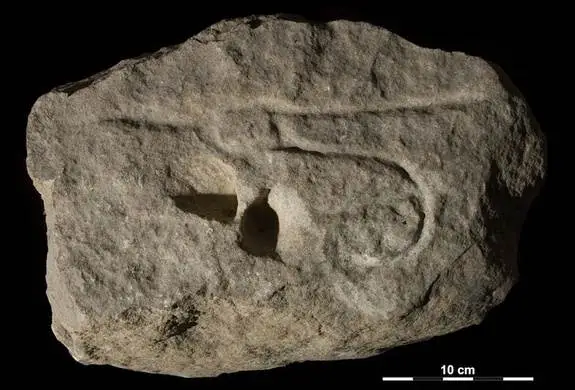Can you see the vulva in this picture? Well, it’s there, and it’s ancient! A recent discovery was made of 37,000-year-old wall art — possibly the first-ever wall art — at Abri Castanet in southern France. And upon closer inspection, it seems like these primitive humans had a great appreciation for female sex organs, so much so that they drew it all over the walls of caves. And it was the first thing they ever wanted to draw on the walls of caves! (Plus some animals and things, but most notably, vulvas.) So, what are we to make of this? Were primitive humans pervs? A lot less inhibited than people are today? Celebrating the female form? Or just simply practicing still-life?
Before the discovery in Abri Castanet, researchers believed they’d found the first known wall art in the nearby Chauvet Cave. The proximity of the sites suggests that the artists themselves came from the same group of primitive humans, the Aurignacian culture, which existed for about another 10,000 years after the Abri Castanet art was said to have been made. These are also believed to be one of the first groups of modern humans to leave Africa for the Eurasian continent.
So, what’s with the lady parts? Art historians will tell you that many ancient cultures were not shy about the female form and depicting it in various forms of art, including the famous Venus statues, which symbolized fertility and were likely used as “good luck” charms or talismans in hopes of easier childbearing. They featured exaggerated female sexual organs and breasts, as if to say “Look, we’re really serious about making babies to further the human race, so check out the massive mons pubis on this statue we made. And these large breasts, perfect for feeding the baby you’ll give us. For real, this is a grand example of a female, and we hope you appreciate it!” Though the wall art is obviously cruder and less detailed — and less recognizable — than a statue in the shape of a woman, all the pictures found on the walls suggest things that were simply part of the Aurignacian way of life, including the ladyfolk.
The Aurignacians do have their own famous Venus statue, though, the Venus of Hohle Fels, which was a blatant reproduction of the female form featuring not just a pronounced vulva, but some very prominent labia majora. This was found in a cave in southwestern Germany, and may have even been worn as a pendant:
“All place an emphasis on sexual attributes and lack emphasis on the legs, arms, face and head, made all the more noticeable in this case (the Venus of Hohle Fels) because a carefully carved, polished ring — suggesting that the figurine was once suspended as a pendant — exists in place of a head,” [Nicholas] Conard [paleoanthropologist at the University of Tubingen] said.
Vulvas on the wall, vulvas and labia majora on pendants … the Aurignacian people were very into their lady parts. Not that much has changed, really.
Photo by Raphaelle Bourrillon
(via MSNBC)








Published: May 15, 2012 12:42 pm